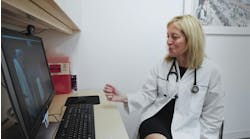ParkinsonNet was founded in 2004 in the Netherlands to improve the lives and guarantee the best possible care for people impacted by Parkinson’s disease. One of its goals is to include patients in decision making about care pathways and to connect the clinicians to make care more patient-centered. Since then, it has gradually grown into a global network, and a clinical team from Kaiser Permanente’s Southern California region recently discussed their ParkinsonNet effort.
Christopher DiStasio, M.D., Regional Chief of Service, Neurology for Kaiser Permanente, Southern California; Nicole Adachi P.T., D.P.T., Board-Certified Clinical Specialist in Neurologic Physical Therapy, for Kaiser Permanente, South Bay Medical Center; and Patrick Hickey, D.O., Neurology, Kaiser Permanente, Los Angeles Medical Center, engaged in an e-mail Q&A with Healthcare Innovation to discuss the impact of the ParkinsonNet model on their patients.
HCI: How and when did Kaiser Permanente get involved with the principles of ParkinsonNet?
DiStasio: Kaiser Permanente became involved with ParkinsonNet in 2013 when our Care Management Institute identified this innovative, evidence-based approach to improve the care of patients with Parkinson’s disease. A team of Kaiser Permanente specialists including neurology, physical therapy, and administrative partners met with the ParkinsonNet team at Radboud University Medical Center in the Netherlands. We were impressed by how aligned this integrated, patient-centered, and evidence-based approach to care was with our own integrated care delivery model at Kaiser Permanente, and found that this program was the best way to provide care for this complex disease.
What are some components of patient empowerment that the process uses? Does it involve co-designing care plans with patients to make sure the care plan includes their priorities? Can you provide any detail about how that input was captured and included in care plans?
DiStasio: In the early development phase of adopting this program at Kaiser Permanente, we conducted interviews with a number of our Parkinson’s disease patients along with their family members and caregivers. We asked for honest feedback on what we were already doing well and what we could improve to provide better care. This was completed with help of our video ethnography team and the interviews took place in clinics and even in-home. This work gave us profound insights and showed us that our patients need compassion, communication, and coordination of care from their care team. Patients want Kaiser Permanente to be partners in their journey and for us to help put all the puzzle pieces together.
Post-implementation insights from our patients showed that we have made vast improvements, and we are continuing to find opportunities to strengthen communication channels through utilizing digital and virtual patient tools.
Adachi: In therapy, we empower patients to learn how exercise can slow disease progression and improve their quality of life. Before the Parkinson's care program, patients who were newly diagnosed with Parkinson's were not usually referred to physical therapy. Now patients with Parkinson's see a physical therapist shortly after their diagnosis and learn how important exercise is in their treatment plan. It has been wonderful to build relationships with the patients and their family members and see them over the years.
Prior to the pandemic, we provided exercise groups for people with Parkinson's disease. The participants said they enjoyed the groups since it provided motivation for them to exercise, and it was encouraging for them to talk with other people with Parkinson's. Many of the participants became friends and stayed in contact after their sessions were over.
I read that one aspect involved creating an online community platform for providers and patients, which led to the creation of a Parkinson’s Disease knowledge base for patients, family members and providers, which enhances self-management. Can you describe that platform?
Hickey: We spent over a year developing a website directed towards Parkinson’s disease patients and their caregivers. The website addresses common questions about Parkinson’s disease, such as how it is diagnosed, common symptoms patients experience, treatment options, as well as an overview of how Kaiser Permanente approaches patient care. It can sometimes be a challenge to address all questions during an office visit and patients often have additional questions after a visit, so this has been a valuable resource that we can provide to improve patient knowledge base and empowerment.
In addition to being a useful informational tool, the website also serves as a way to engage our members by posting community resources, conferences, and other Parkinson’s disease educational opportunities. While the website is focused on our Southern California members, it’s also accessible to those outside of Kaiser Permanente and we are developing more region-specific versions as well.
Could you describe a few other elements of the program that are important — such as building networks of providers?
DiStasio: Social medicine is a key element of the program, including patient support groups, coping with Parkinson’s disease classes, and one-on-one services. Offering educational classes for patients and caregivers empowers them by providing knowledge and tools that help maximize function and quality of life for patients with Parkinson’s disease.
Kaiser Permanente is also planning a Parkinson Disease Summit to bring together providers, therapists, patients, and caregivers to further strengthen our collective knowledge and experience, and foster collaboration. This, unfortunately, has been delayed due to the pandemic, but it will continue to be a priority in the future.
Adachi: Additionally, one-on-one services with physical therapists, occupational therapists, and speech therapists is a very important aspect of this program, specifically with specialists who have specialized training and experience to care for people with Parkinson’s disease.
Therapists, providers from neurology, patients with Parkinson's, and their families came together to create a Kaiser Permanente team to fundraise for and participate in the Parkinson's Foundation Moving Day Walk, which was a very inspiring event.
Hickey: Another aspect of this program is to recruit Parkinson’s disease trained therapists, such as physical therapists, occupational therapists, and speech therapists and support their continued education in this field. We have established a curriculum to educate interested professionals on best practices of Parkinson’s disease care through a series of articles, videos, and expert lectures. Certified therapists are expected to maintain their proficiency through direct patient management with Parkinson’s disease patients. In addition, we hold quarterly Parkinson Master Clinician training lectures where specific care concerns are discussed by an expert clinician.
Has Kaiser Permanente studied the impact of the implementation of this program on clinical outcomes and on patient perceptions?
DiStasio: Yes, since implementation in 2015, we have seen major success and positive outcomes in this program at Kaiser Permanente, including a 97 percent increase in physical therapy visits, 146 percent increase in occupational therapy visits, 64 percent increase in speech therapy visits, 17 percent decrease in admission rates, 50 percent decrease in overall fractures, and a 60 percent decrease in hip fracture rates.
Is this work still ongoing?
DiStasio: Our work with the ParkinsonNet program is ongoing and as we learn more and receive additional feedback from our patients, we continue to improve the care we provide.
Adachi: Because of the success we have seen with ParkinsonNet, Kaiser Permanente neurologists, physical therapists, occupational therapists, and speech therapists also provide trainings to other health providers on updates in treatment and to share best practices in caring for those with Parkinson’s disease.
The ParkinsonNet website shares this quote from Dr. DiStasio:
“ParkinsonNet has made a demonstrable impact on the care of our PD patients while providing them the opportunity to actively participate in their own health, well-being and remaining the center of our team. Since the inception of the program there has been a greater than 60 percent reduction in falls and hip fractures in our PD patients.”
Are there aspects of the program to which you attribute that remarkable improvement? Are there other metrics you could share? Or anecdotal comments you hear from patients about being more involved in their care decisions?
DiStasio: This program works because it leverages the integration of multiple care services, including movement disorders specialists, neurologists, physical therapy, occupational therapy, speech therapy, social medicine, primary care, and many other services with our patients and their families. The therapy modalities are evidence-based and focus on quality of life and this is important for each patient.
Anything else you would want to stress about this program?
DiStasio: ParkinsonNet is a great example of how to provide excellent care for patients with complex diseases that require coordination across many specialties and services, in order to keep the patient at the center of care.


